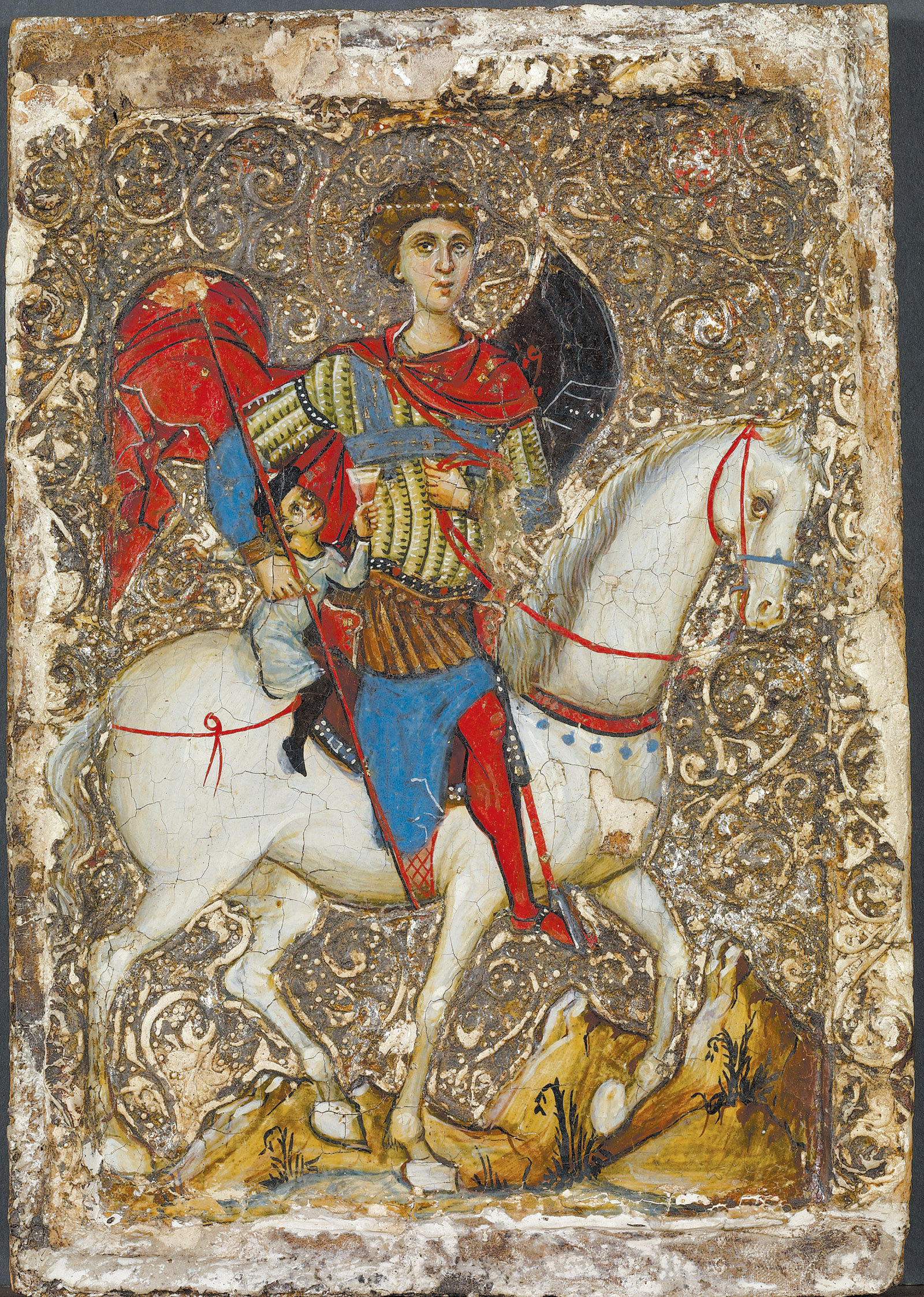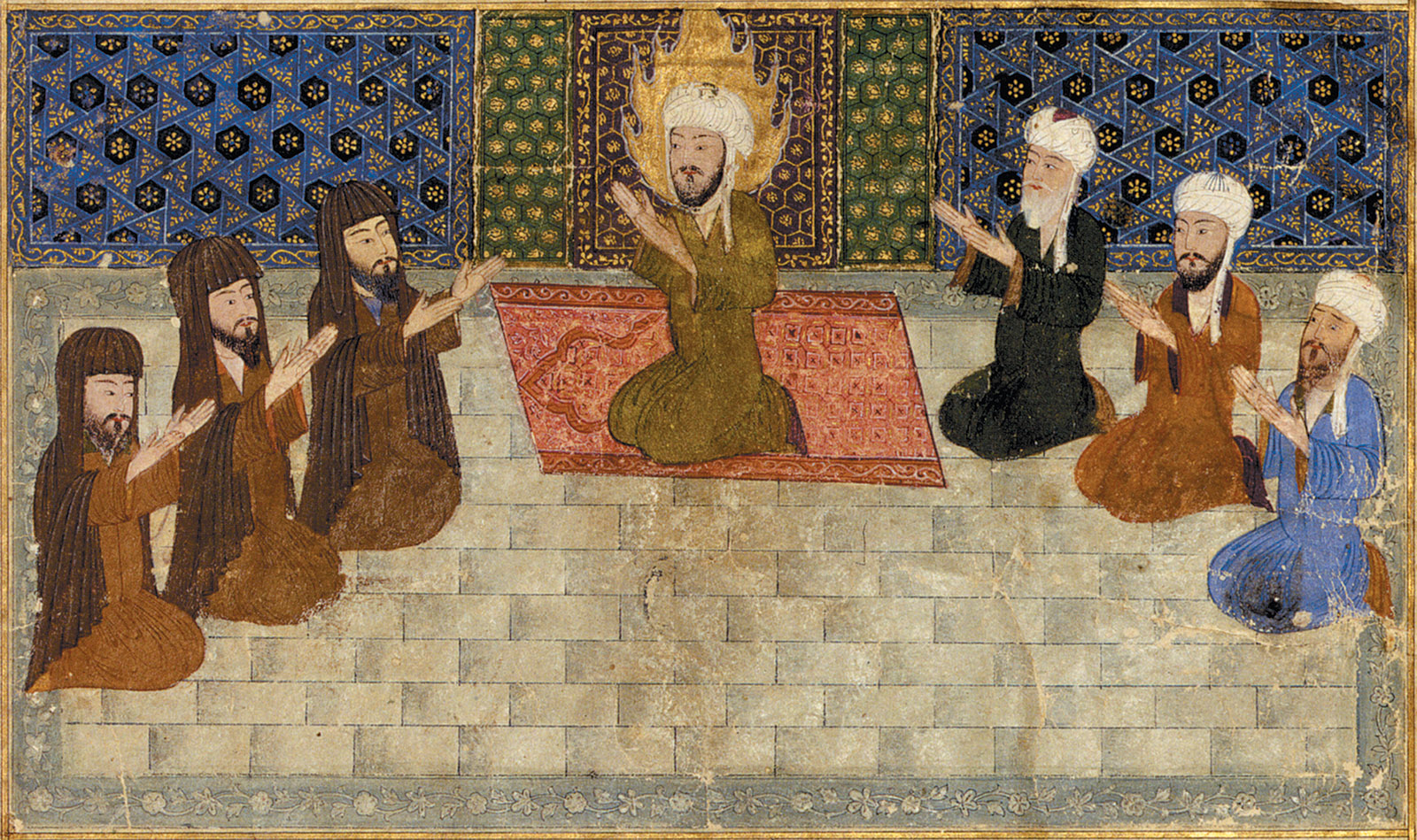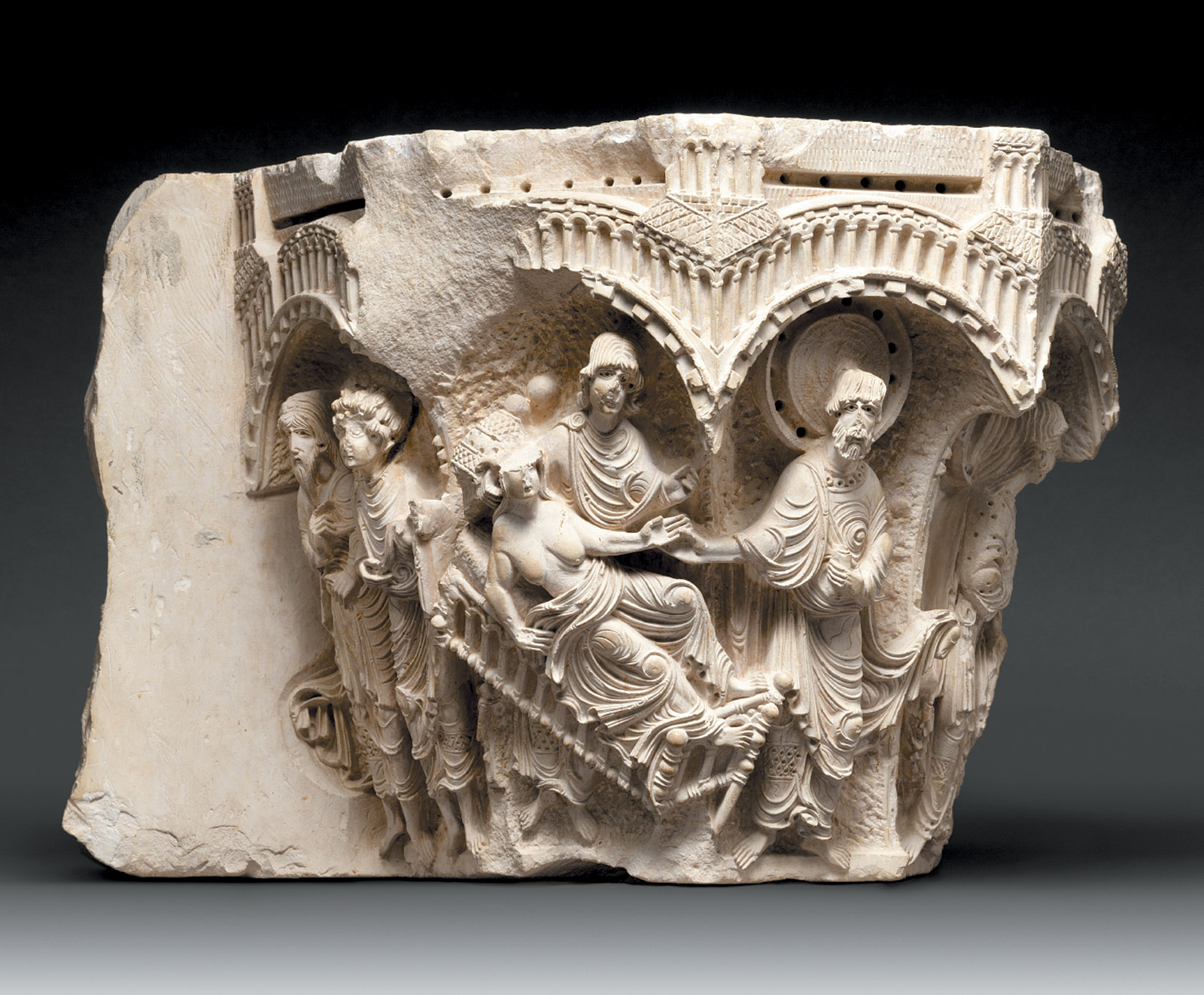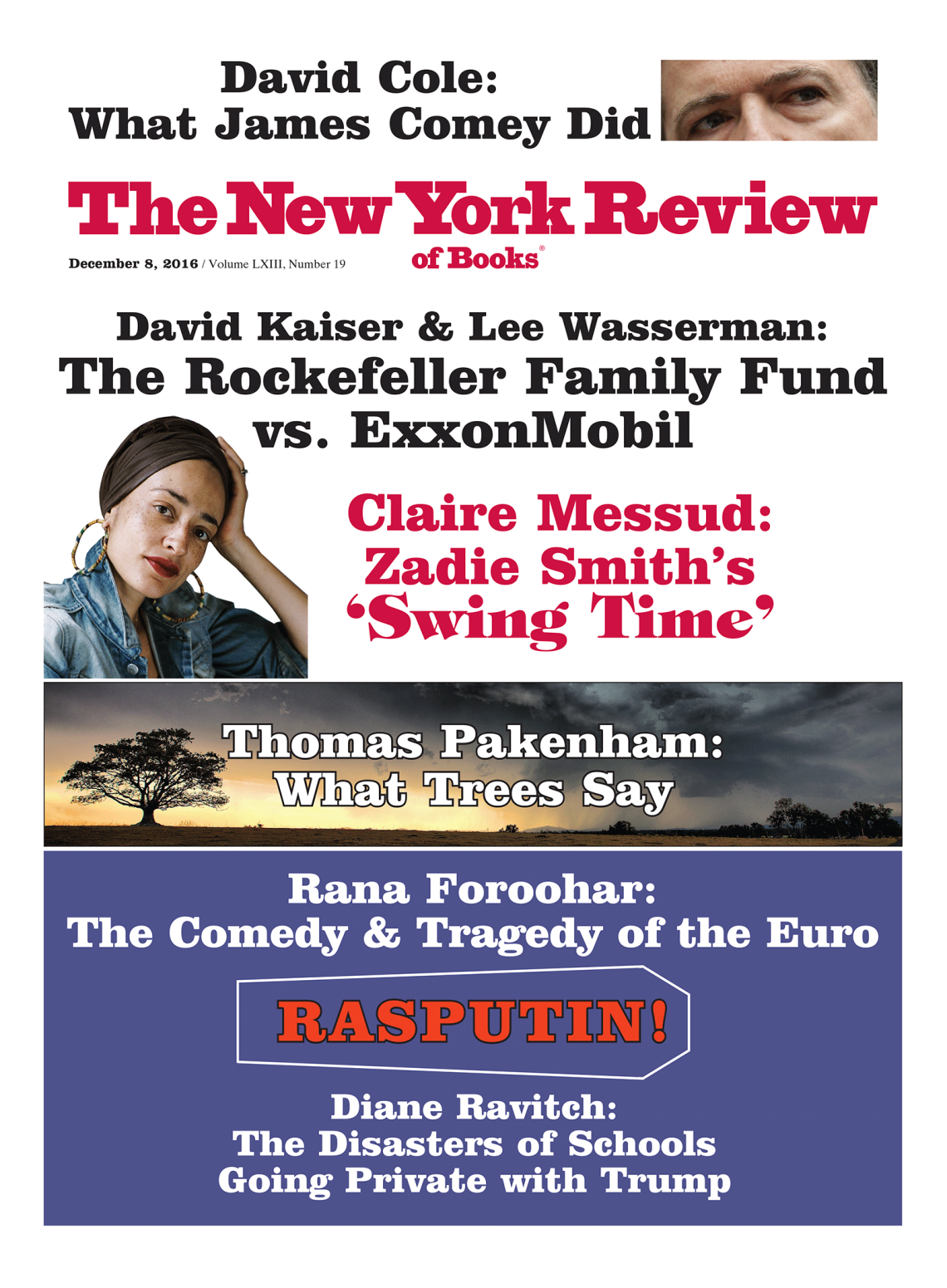
British Museum, London
‘Icon with Saint George and the Young Boy of Mytilene’; Holy Land, mid-thirteenth century. According to the ‘Jerusalem’ exhibition catalog, ‘The jug and wineglass held by the youth connect the image to a popular miracle account in which a boy captured by Saracens is made to serve as cupbearer for an amir and pressured to convert to Islam.’
The exhibition at the Metropolitan Museum of Art “Jerusalem, 1000–1400: Every People Under Heaven” has risen to the challenge of portraying a remarkable period in the history of a most unusual city. Between 1000 and 1400 Jerusalem lived many lives. In 1000, it was a provincial city, governed from Cairo by Muslim rulers. Then the unexpected happened. Between 1099 and 1187, Jerusalem fell into the hands of foreigners from the distant West, known to us as Crusaders, but usually known to their Middle Eastern neighbors as “Franks”—Firanghi.
In 1187, the city returned to Muslim rulers. But these rulers were, in many ways, as much outsiders as the Franks had been. They were not Arabs, but Turks and Kurds—self-made men of the sword who had risen to power in the turmoil that had followed the Seljuq Turkish infiltration of the Middle East from 1050 onward. Indeed, the Mamelukes who would govern Jerusalem in the thirteenth and fourteenth centuries were warrior-slaves recruited from all regions. They were as diverse as the French Foreign Legion. One of the most successful Mameluke generals was even a former member of the Teutonic Knights. Faced by such rulers, the average inhabitants of Egypt and Palestine could well have asked themselves if the knights had ever gone home.
Yet throughout this kaleidoscope of regimes, the life of Jerusalem continued. The Met exhibition has recaptured for us the vibrant commercial and cultural life that persisted through so many political and religious changes. The opening room of the exhibition concentrates, with unabashed zest, on this theme. The first thing we see is a pile of bright gold coins minted in Egypt, and discovered in the port of Caesarea in 2015. The gold in these coins came from the gold-rich rivers of sub-Saharan West Africa. For the very first time in history, Muslim caravans had conquered the Sahara desert (an ocean of sand as formidable as the Atlantic) that lay between West Africa and the Mediterranean, releasing a stream of precious metal into the Islamic world.
The elites of all regions and religions floated on this bed of shared opulence. In the same room, a bronze platter bears the coat of arms of the Lusignans, nominal kings of the Crusader Kingdom of Jerusalem. The platter was made for them in Egypt or Syria. The Western coat of arms is surrounded by an Arabic blessing: “power, victory, and long life to the noble, the good….” For the noble and the good—and especially for the warrior elites who bore the formidable swords that stand out in the far corner of the main exhibition room—Jerusalem, for all its tensions, was not a bad place to be.
The organizers of this exhibition, and the principal contributors to the catalogue—Barbara Drake Boehm and Melanie Holcomb—are to be congratulated for their emphasis on the shared prosperity, the grace, and the cross-cultural ingenuity of the objects that they have assembled from every corner of Europe and the Middle East. The exhibition is both an eye-opener and a delight to the eyes.
But their agenda is more serious than that. They linger by preference on the commercial life of Jerusalem. They stress the religious and ethnic diversity of its inhabitants and of its travelers and pilgrims. They remind us of the quiet elegance of its late medieval buildings—the fountains and the delicate façades of palaces, past which we tend to hurry on our way to the better-known sights of the city.
Boehm and Holcomb linger to a purpose. It is their intent to erode a peculiarly tenacious and dangerous stereotype. In the firm words of Thomas Campbell, the director of the Metropolitan Museum:
From today’s vantage point, Jerusalem seems destined to host unending, unrelenting conflict among the three Abrahamic religions that deem it holy: Judaism, Christianity, and Islam. Sectarian conflict is sadly the easiest tale to spin, but Jerusalem’s history is in fact much more nuanced.
The exhibition makes a clear case against rigid stereotypes and in favor of nuance. We are constantly reminded of the mutual awareness of the different groups in the city, and of the extent to which they shared not only a common commercial way of life but also, in innumerable, almost subliminal ways, a common religious culture. The modern image of Jerusalem as a city strenuously zoned according to religious and ethnic criteria disappears at the touch of this evocation of its medieval past. We find ourselves back in the helter-skelter of a Middle Eastern city, where many of the barriers erected in more recent times were not yet to be seen. We need to be told this. When, in his praise of Jerusalem, the Italian Jewish Talmudist Elijah of Ferrara writes, in 1434, that “the Jews ply their trades side by side with the Ishmaelites [the Muslims], and no jealousy between them results such as I remarked in other places,” we are not simply being treated to an interesting bit of historical trivia. We are looking into a world challengingly different from our own. A little fragment of the permafrost of the stereotype of Jerusalem as an eternally divided city melts in the back of our minds.
Advertisement
The organizers of this exhibition have laid out, with deep respect for their distinctive messages, the artifacts that speak to the differing expectations of Jews, Muslims, and Christians as they approached the holy city. The rows of Jewish prayer books convey the sense of longing for the Temple. The plan of the Temple, destroyed by the Romans in 70 CE, was lovingly traced in innumerable ways—even by lines made up of tiny letters. Its instruments of worship were shown in burnished gold, against backgrounds as sumptuous as any late medieval heraldic shield or Book of Hours.
As for the Muslims, we catch a hint of the imperial majesty of the Dome of the Rock as it floated, spacious and silent like a royal garden, above the narrow streets of the city. Whether it came from the mountains of Ethiopia or from the estuary of the Rhine, the Cross of Christ is shown in a variety of forms. Huge reliquaries decorated with enamel and precious stones enclose slivers of the wood of the Cross, as if their makers strove to make visible, through opulent metalwork, the glory hidden in these tiny fragments.
Why were these centuries so violent? The answer given by Boehm and Holcomb is humane but rather limp:
We recognize that conflict can cause wanton destruction, but we find, sadly and paradoxically, that it can also spark creativity.
For the historian, perhaps, the saddest paradox of all may be that it is often creativity itself that sparks the conflict and escalates the destruction. For creativity often means the abandonment of old restraints. In a new world, new things become possible. And these new things can include hitherto unparalleled acts of bloodshed. This was the case throughout the Middle East during the Crusades and after. Massacres of Jews and Muslims by Christians accompanied the taking of Jerusalem in 1099. A few centuries later, for the first time, massacres by Muslims cowed the Coptic Christian population of Egypt. Neither of these two outbursts was a recrudescence of some primal hatred. Rather, they pointed to new situations, where older restraints on interreligious violence had become eroded. How may this have come about?
Up to the year 1000, Europe and the Middle East had moved to the slow tick of an ancient clock. Old-fashioned empires controlled much of the known world. The Caliphate of Baghdad has rightly been called the last great empire of the ancient world. It still looked back, over many centuries, to the late antique world of Sasanian Persia and Byzantium. Byzantium itself still claimed to be the heir of ancient Rome. The Byzantine emperor was regarded as the natural protector of the Christian holy places of Jerusalem. The tomb from which Christ was held to have risen from the dead was sheathed in Byzantine gold. Muslim legends held that the Byzantine emperor himself would visit Jerusalem incognito every year, to take part in the solemn Easter service at the Church of the Holy Sepulcher.
After the millennium things began to change. A remarkable study by Gideon Avni has shown that in the countryside of Palestine, the first Arab invasions of the seventh century CE had created little discontinuity.1 For many centuries later, the countryside seemed still to bask in the long late afternoon sunlight of Roman times. Then, around 1000 CE, it is as if the weather broke: villages emptied out, the run-off irrigation of the Negev region failed, peripheral settlements gave way to the desert. Maybe the climate itself changed. It has even been suggested that solar flares dried out the ancient landscapes of the Middle East while bringing new life and increased population to the dank fields of northern Europe.
Alongside this possible mutation, the infiltration of the Turks into the Middle East and the establishment of feudal regimes in Western Europe, and then in the Crusader kingdom of Jerusalem, brought to the fore new types of rulers. The pious Godfrey of Bouillon, Duke of Lower Lorraine, the second son of a noble family, was offered the kingdom of Jerusalem in 1099. Salah al-Din (Saladin) was a gallant Kurd who received its surrender in 1187. Both were new men, both forging their own way in a world without empires. It was not an atmosphere that favored restraint.
Advertisement
This exhibition does full justice to the positive side of this development. The new elites were patrons of an art that was both worthy of their ambitions and suited to their means. The sheer brilliance and diversity of the art shown blinds us to a fact almost too big to be seen: so much of it was a new art, based on the unparalleled exploitation of new skills. Whether it is the stunning lusterware of Egypt and Syria, whose ceramic surface seems wrapped in a haze of gold, or the exquisite, psychedelic colors of the enamels produced in the Meuse valley at the time of the Crusades, we are dealing with technological innovations pursued with unparalleled skill.
Most of these artifacts were made for the moderately rich—for minor bureaucrats, soldiers, and urban notables in the Islamic world, and for their equivalents, the petty noblemen, merchants, and clergy of the West. Whether in Cairo, Jerusalem, or Damascus, it was an age with new elites, who delighted in new skills and in new combinations of materials and ideas.
Nothing shows this more vividly than one of the most surprising items in the exhibition—the capitals found in the Church of the Annunciation at Nazareth. Buried at the time of the fall of the Crusader kingdom, these masterpieces emerged intact around 1900. In them we catch a moment when the Christian imagination was balanced between East and West. The capitals show the deeds of various Apostles. Exquisitely carved, the figures gesture and dance as if possessed by holy energy. One scene is framed by echoes of Islamic honeycomb vaulting—the famous muqarnas ornament. The stories that the carvings tell show the influence of Eastern Christian legends. An Apostle is led by the Virgin through Hell, past horrendous devils armed both with Turkish reinforced bows and with Crusader kite shields. Saint Matthew appears in far distant Ethiopia, preaching to its king and battling with sorcerers for the soul of his daughter, who bore the strangely classical name of Iphigenia.
But the problem of violence remains. Creativity led to greater confidence in one’s own views and to increased impatience with the compromises and ambiguities on which real tolerance had depended. Alas, harder boundaries appealed to sharper minds. We need only look at the pileup of splendid texts and maps related to Jerusalem produced in the universities, monasteries, and courts of Christian Europe in the thirteenth and fourteenth centuries to realize that we are witnessing the emergence of a learned intolerance that cut deeper, in some ways, into the texture of the Middle East than did the swords of the Crusaders.
It did not have to be like this. In a recent thought-provoking book, Christopher MacEvitt has shown that the first Crusaders in the Latin Kingdom of Jerusalem practiced a “rough tolerance” in relation to the non-Catholic Christian populations who had survived in large numbers throughout Syria and Palestine.2 Adventurers in an age of flux, the Franks took things as they came. They did not ask too many questions about the confessional loyalties of the local Christians. Potentially irresoluble conflicts of belief between the groups of Christians in the Holy Land were finessed through “the dark and quiet way of rough tolerance.” It was “an era of unspoken compromise and unacknowledged ecumenism.” We need only look at the splendid Psalter of Queen Melisende, the half-Armenian ruler of Jerusalem from 1131 to 1153, to appreciate the result of this rare moment of mutual respect. It is a work of Byzantine grace, in which King David is shown, on the ivory binding, not as a Frankish ruler, but in the venerable jewel-laden robes of a Byzantine emperor.
This moment passed. By the end of the Middle Ages, even the most open-hearted Western pilgrims to Jerusalem carried with them a carapace of notions about the Middle East that already bore an uncomfortable resemblance to our own stereotypes of the region.
One of the pilgrims, Felix Fabri, was a Dominican friar from Ulm. In 1483, he went on an extensive pilgrimage to Jerusalem and Mount Sinai. We know him well through his Evagatorium—“The Story of My Wanderings”—and through two delightful books written about him by the historian and historical novelist Hilda Prescott.3 Fabri was not a bigot or an ideologue. Nor was he blinkered. He knew how much a pilgrim might gain from remaining open to the world around him. He would gain knowledge, he wrote,
about men of all lands, both Eastern and Western…. He likewise receives an experience worth more than all [that. He] begins to know himself…. I confess that I never saw my shortcomings and vices better than…in the desert in a tent, for in these places no part of a man’s character remains concealed.
Fabri was also a successful product of his education as a good Western Christian. There were forbidden areas in his mind. For this reason, his magnificently full and self-aware account is of particular use to us. For what Fabri chose to see and what he failed see are signs for the future of Europe’s image of the Middle East.
Fabri’s principal responsibility had been to shepherd a party of German knights. This was no easy task. Large, testy men, used to carrying heavy metal, they did not take kindly to being teased by Arab street urchins. In the Church of the Holy Sepulcher, they sat around talking knight-talk: “about princes and quarrels, about the campaigns which they had served.” Worse still:
They went up into the chapel of Mount Calvary and bowed themselves down upon the holy rock…. They would pretend to be praying, and within the circle of their arms, they would secretly scratch [on the rock]…their shields.
(Nowadays, their successors of all nations take “selfies.”) They went on to do the same at the monastery of Saint Catherine at Sinai—so that the warm stone vaults of the monks’ refectory are now covered with florid heraldic shields, as if it were a southern German Ratskeller.
Worst of all: they were riveted by the Dome of the Rock. Viewing it from Mount Zion, across the Valley of Jehosaphat, they declared that there was “nothing more glorious or more beauteous within sight.” Friar Felix felt he had to put them right: it was an “abominable and desecrated church,” in which “Mahomet the accursed is praised.”
Though a hard-liner in public, Fabri was nonetheless drawn to what he saw of Islam. A southern German, used to the dramatic carvings of his churches (he was a near contemporary of Tilman Riemenschneider), the empty spaces of the mosques struck him as somewhat uncanny:
No altar, no image either painted or carved, no wooden seats, benches, or stalls, but the whole pavement of various hues of polished marble…. There is nothing at all within, save…lighted lamps hanging down from the vault above.
Yet Muslim decorum impressed him greatly. He noted that the pavements outside the Dome of the Rock were spotlessly clean, trodden on only by bare, washed feet. Most noticeable of all, each believer walked
with gravity and decorum, not in troops [that is, without an entourage of servants and hangers on, as would be the case when German noblemen went to church], but each man walks alone, even though he be a great lord.
Fabri had glimpsed an essential aspect of Islam. Ultimately, all believers, regardless of rank, must stand alone before their God.
He even accepted the fact that Muslims and Christians might share the same shrines. He noticed that some Muslims joined in the weeping at the Church of the Holy Sepulcher. He found that the cracks in the rocks in the Chapel of Calvary were filled with strands of hair and cut-off beards. Muslims who wished to be cured of toothache would deposit these as votive offerings and would scrape dust from the walls of the holy place to mix in medicines.
Ambivalent about Islam, Fabri had no time for his fellow Christians of the East. He was proud to belong to “the civilized household of the Catholic faith,” not to the “wild men of…schismatic dissent.” For him, Eastern Christianity could be written off. It was “a mere wreck”—a Babel of cantankerous “minorities.”
A singular merit of the Met exhibition is that it challenges such a view. It does full justice to the presence in Jerusalem and elsewhere of the ancient Christian communities of the Middle East—Greek, Syrian, Coptic, Armenian, and Georgian. Each group had its own distinctive history and is represented here by its own distinctive artifacts. Each produced great volumes of prayers and Bibles whose script and decorative patterns often went back to Roman times. They belonged to a more ancient world than did the upstart Christians of the West.
It is important to stress this Middle Eastern Christian presence. In 1000 CE and even later, the fate of Christianity in the Middle East was far from being settled. In many areas of Egypt, Syria, and the Caucasus, Christians had remained in the majority. It was Islam that was the “minority” religion, floating on a sea of largely undisturbed Christian populations.
Further to the south, at the base of the Red Sea, Ethiopia remained a proud Christian realm. Annual caravans of over three hundred Ethiopian pilgrims to Jerusalem would make their way north along the coast from Axum, passing the great Coptic monasteries of Saint Paul and Saint Anthony at Qulzum in Egypt. These caravans reminded the Muslim authorities that the Red Sea was not yet an entirely Muslim lake.
The Ethiopians had their own chapel in the Church of the Holy Sepulcher. Thin, tall men, burned by the fierce sun of the south, they bore on their faces tattoos of the cross—on their forehead, nose, and cheeks. They danced when they worshiped:
All of them, of both sexes, begin to sing praises, and to jump…and clap their hands together, assembling together in circles…and sometimes they sing in this manner all night long.
They danced as King David was believed to have danced, over two millennia before, in front of the Ark of the Lord in Jerusalem.
Felix Fabri watched them with interest but without enthusiasm. They were not part of his world. Along with their fellow Christians of Asia and Africa, “for them the true sun has set.”
Viewed with hindsight, in the light of the tragic events of our own days—the threatened elimination of the Christian communities of Syria and Iraq—one of the most shocking sequels to the Crusades may well turn out to have been the chilling ease with which a learned and self-confident Western church forgot its Eastern brothers.
But to give him his due, though a university man, Felix Fabri had a heart. He confessed that he fell in love with the desert of Sinai. The vivid whites, blacks, and reds of its mountains meant more to him than the monotonous green fields of Egypt to which he finally arrived. And in Egypt, just before his final departure for home, he met a holy man. The boat from Cairo to Alexandria was joined by a Muslim ascetic from an order vowed to perpetual silence: here was a man, Fabri wrote,
of so great, and if it is not wrong to say it, of so spiritual a discipline as could nowhere be found among the Religious [Orders] of Christendom, and it was as if the holiness of the man shone in his countenance. I would have been glad to speak with him if I had known his language.
It is a sudden, blessed moment of genuine respect. A barrier dropped. If this magnificent exhibition has helped us, with modern skills and in a more modern idiom, to remove further barriers and to experience further moments of respect, then we should be very thankful.
-
1
See Gideon Avni, The Byzantine- Islamic Transition in Palestine: An Archaeological Approach (Oxford University Press, 2014), pp. 333–353. ↩
-
2
Christopher MacEvitt, The Crusades and the Christian World of the East: Rough Tolerance (University of Pennsylvania Press, 2008). ↩
-
3
Les errances de Frère Félix, pèlerin en Terre sainte, en Arabie et en Égypte (1480–1483), edited by Jean Meyers and Nicole Chareyron (Montpellier: Université Paul-Valéry, 2000–2006), in Latin and French; The Wanderings of Felix Fabri, translated by Aubrey Stewart, Palestine Pilgrims’ Text Society, Vols. 7–10 (London: Palestine Exploration Fund, 1892–1897); H.F.M. Prescott, Jerusalem Journey (London: Eyre and Spottiswoode, 1954) and Once to Sinai (London: Eyre and Spottiswoode, 1957). ↩




